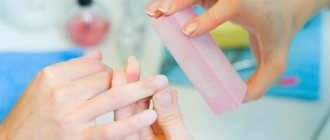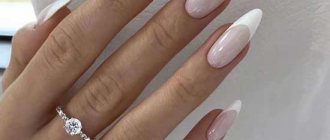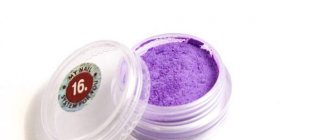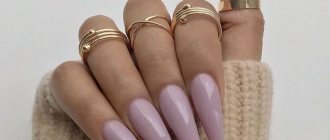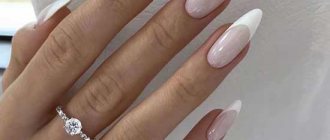A nail file is the main tool of a nail technician. No matter what technique you use, you can’t do without a nail file. You can cut the length of your nails with a cutter, but you can only achieve the ideal shape with a file. Both the speed and quality of the sawdust depend on the correct choice of shape and abrasiveness of the tool.
Files are made by gluing fine abrasive chips made of aluminum oxide, quartz, silicon carbide, Teflon, etc. onto a solid base. The base can be wooden, plastic, metal, glass and cardboard.
For professional use in salons, either disposable files on a cardboard base or steel files with replaceable files are suitable. As a last resort, you can have a separate reusable file for each client. But no abrasive lasts forever, and after a couple of procedures, the filing process will take longer.
Abrasiveness of nail files
On professional instruments it is usually marked on the file itself next to the manufacturer’s logo. Most double-sided files have different abrasiveness on each side, which is indicated by numbers: 100/150 or 180/240, for example.
The hardness of saw blades is measured in grits. Grit - the number of abrasive grains per 1 square centimeter. The larger the grains, the fewer there are per unit area, and the coarser the abrasive. And vice versa, the higher the grit index, the finer the processing will be. The figure below shows the grit scale:
From left to right from coarse to fine abrasive.
180 grit, marked in green, is a borderline value. All abrasives marked to the left on the scale (purple and red) are suitable for filing artificial materials and artificial nails. Everything on the scale to the right of 180 is intended for filing natural nails. A coarse abrasive can leave deep scratches and split natural nails, so it is prohibited to file natural nails with artificial nail files.
Selection rules
- 60 and 80 grit - allow you to quickly file artificial nails made of hard acrylic. Use them if you have applied too much material, but try not to touch the cuticle area with them.
- 100-150 grit - suitable for filing artificial nails made of gel, acrygel, correcting gel polish bases and other not too hard materials. Manufacturers strive to create easily fileable gels and acrygels, so some of them can be filed with a 180 degree file.
- 180-240 grit - copes with giving the desired length and shape to the free edge. A value of 180 is more suitable for strong nails or nails that still have a gel polish base. 240 - for thinner and softer natural nails without strengthening or coating.
- 320-400-600 grit is a grinding abrasive that can be used to slightly smooth the surface of the nail plate, removing longitudinal grooves before polishing. As a rule, sanders have a soft springy base.
- 3000-4000 grit - polishing. Designed to give a bright shine to the nail plate.
Thus, the most universal in modern working conditions (when manicure is almost impossible to do without gel polish) will be an abrasive of 180 grit. They can adjust the reinforcement, file the repaired free edge, and give it the required length and shape. It is also suitable for pedicures - in most cases, toenails are thicker and stronger than those on your hands.
The best files for natural nails
The category offers a wide selection of metal, glass and ceramic files for the care of natural nails. All accessories are of high quality, durable and tolerate various methods of disinfection.
Royal Tools file with sealing effect
5
★★★★★
editorial assessment
100%
buyers recommend this product
This innovative nail file has already captivated many manicurists. It is made of high quality steel and impact-resistant plastic. The shape is oval and slightly curved - for convenient filing of edges.
The sides have different abrasiveness: the first is suitable for length correction, the second, smoother, is for grinding and sealing the edges of the nail. The use of such an accessory stops delamination and prevents chemicals from getting inside the plate.
Pros:
- High-quality manufacturing materials;
- Comfortable handle and curved shape of the file itself;
- Hard storage case;
- Removes length and seals the edge of the nail;
- Sides with different abrasiveness.
Minuses:
- It costs expensive.
The premium English brand Royal Tools produces professional manicure tools. Only high-quality materials and new technologies are used for products, thanks to which they last for years.
Zwilling JA Henckels Ceramic 88418
4.9
★★★★★
editorial assessment
95%
buyers recommend this product
A shaped nail file with a wide plastic holder is considered one of the safest. The work area is made of ceramic in the form of a rectangle. The corners are quite sharp and make it easy to trim your nails and also seal their edges.
This device can be used to treat cuticles, nail folds, and even remove hangnails. The handle has a pleasant and discreet pastel shade: blue, pink, white or blue - your choice.
Pros:
- Wide comfortable handle;
- Safe ceramic file;
- Suitable for caring for fragile, brittle nails and cuticles;
- Seals the edge;
- Lightweight and durable.
Minuses:
- The price is a bit high;
- The non-standard handle takes some getting used to.
To prevent your nails from deteriorating and peeling, you need to take proper care of them. This accessory will help you with this. Ceramics with fine and uniform grain size are safe for the health of nails, and also quickly remove length and give the desired shape.
Silver Star AT 467
4.8
★★★★★
editorial assessment
90%
buyers recommend this product
Silver Star products are no less in demand. It produces inexpensive and convenient tools, including nail files. Model AT467 is made of a ceramic bar placed in a plastic case.
On the opposite side there is a narrow pencil file for caring for the cuticle and skin around the nail. The ideal result is achieved by steaming your fingers and carefully filing.
Pros:
- Compact and convenient model;
- Ceramic base;
- Closes with a plastic cap;
- There is an ISO quality certificate;
- Does not break when dropped;
- The work area is not cut down for a long time.
Minuses:
- Over time, the mount becomes loose and the file falls out of the case;
- The cap is easily scratched.
All brand products are certified and meet European standards. The quality of the tool is excellent, but you should not be overzealous when using it, otherwise the skin will become inflamed and hangnails will appear.
Laser file Mertz 140
4.7
★★★★★
editorial assessment
87%
buyers recommend this product
The file is made of steel and has an innovative laser coating for gentle cutting. The sharp corners do an excellent job of correcting the plate in hard-to-reach places, and also serve as the prevention of ingrown toenails.
The instrument is popular among professional craftsmen and ordinary girls. It can be sterilized and treated with various chemical disinfectants. For convenience, there is a plastic handle on the edge.
Pros:
- Suitable for salon and home use;
- Quality materials;
- The right angles of the tool cope with cutting in hard-to-reach places;
- Suitable for removing cuticles;
- Sterilization allowed;
- Inexpensive.
Minuses:
- Roughly affects the nail and leaves roughness;
- No storage case.
The model is small and compact - it will easily fit in a purse or purse. But, like any manicure tool, you need to get used to it.
READ ALSO
5 Best Nail Extension Kits
Nail file shapes
Manufacturers do not limit themselves when producing nail files for household and home use. They can be convex, concave, narrowed, and with decorated handles, so that girls can use them comfortably and pleasantly. Professional files are created for very specific tasks that are solved by the master during work. Let's look at the most popular forms of professional files:
Oval
Universal and most popular, suitable for adding length and shape to both natural and modeled nails, as well as filing repairs and strengthening.
Rounded (boat, crescent)
The most versatile. On the one hand, it is convenient for filing artificial nails in the cuticle area, on the other hand, it has no restrictions when working with the shape of the free edge. It can equally successfully cut both natural and modeled nails.
Rectangular
Also quite common. Suitable for filing the shape, length and architecture of artificial nails. Convenient for cutting creative, geometrically correct arched shapes (edge, stiletto). It can also be used on natural ones, but a large area will remain unused.

Boomerang (arc, banana)
Convenient for filing extended nails in the cuticle area due to the rounded edge, which reduces trauma. It also allows the client to twirl the hand less when filing the free edge.

Diamond-shaped
Suitable for giving shape to artificial nails, as a rule, it is produced for them.

Material of manufacture
Not only the durability, but also the purpose of the tool depends on the material of manufacture. Some are well washed and disinfected, others gently and carefully file the nail, without the slightest damage. Some cannot be used on wet hands, while others are simply contraindicated for use when working with natural nails.
Metal

The most wear-resistant tool is made of metal. It can be washed, boiled, sterilized in other ways without fear of damage. Thin steel bases are convenient for treating hard-to-reach areas, filing down the end and side parts of toenails, or using strong natural fingernails for initial treatment. Steel is not used for polymer plates, since small acrylic chips quickly clog the abrasive and fine notches. You should not use such files for thin, fragile nails, especially those prone to splitting. The notch acts aggressively, damaging the plate at the cut site, leaving hooks and microcracks. A tool coated with diamond or sapphire cuts off the plate using the principle of a conventional grater. After such processing, mandatory grinding is necessary.
Glass, crystal and ceramic
Glass, crystal, and ceramic instruments have an average abrasive value—up to 400 grit. They are designed for various works with both natural and artificial nails.
- Glass ones are gentle, easy to clean, and quite wear-resistant. They can safely remove cuticles. The disadvantage of glass is its fragility - it is undesirable to carry the instrument without a special case.
Glass files are purchased for polishing nails, as well as for working with peeling nails.
- Ceramic bars for manicure work will gently and painlessly remove the layer of dead skin around the nail. Ceramics are stronger than glass, but dropping the nail file is also not recommended.
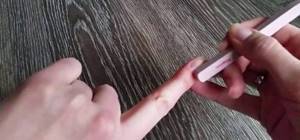
- Crystal bases are made from the famous Bohemian and Czech crystal. They come in different shapes, colors and even with rhinestones. Such a tool will become a precious decoration in a manicure set or handbag.
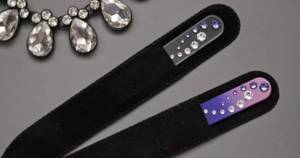
To choose a file for nails prone to brittleness and splitting, you need to understand what causes this. Often, improper filing and improper filing can cause damage to even the healthiest nails.
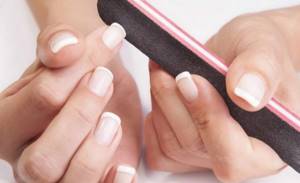
To be confident in your choice, the appropriate file for natural nails will almost always be a ceramic one. It “seals” the edge of the nail plate. It can be used to file away rough skin around the nail. And also for removing dead skin on the elbows and knees, both after softening baths and “dry”.
But you can hardly call it a file for artificial nails. It “gets stuck” in the artificial materials from which the extended nails are made (acrylic, gel). But its therapeutic principle of action is based on this very “linking”.
How to choose a glass or crystal file and not get a fake? The answer is quite simple. Original glassware and crystal products are almost high-tech products and therefore cannot be cheap. In addition, it is practically eternal, that is, it has a lifetime guarantee (if it does not break, like any glass product). And in the case when the seller does not provide such guarantees, it is worth thinking about the quality of the product.
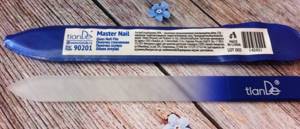
For example, one of the best files for natural nails is the crystal file from Bogema Cosmetics or the Crystal Line glass file from Orly. The latter has a 360 abrasiveness and is suitable for home use, is easy to clean and is not afraid of other hygiene procedures.
Laser
Laser ones have a unique texture and high-quality diamond coating. Due to this, it is not difficult to process the nail in all directions. They seal the edge of the nail plate well without damaging the nail section.
Paper and cardboard
Cardboard or paper files get their name from the base material, on which a layer of diamond chips of varying abrasiveness is applied. The hardness of paper files varies, so it cannot be said that they are not suitable for natural nails. But some specimens are comparable to sandpaper - it is better to use them only on extended nails. Others have the softness of a polishing file.
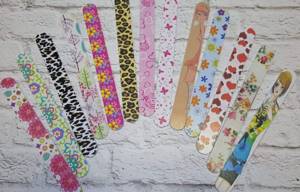
Cardboard tools can only be cleaned dry; moisture causes them to swell and become unusable. The disadvantage of paper is that it is difficult to disinfect, so such files are used only as a personal hygiene item. But the main disadvantage is fragility. Cardboard can withstand only 2-3 high-quality treatments.
Plastic
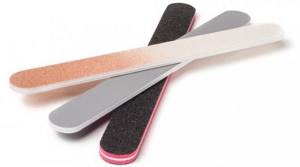
A modern, convenient tool made from foam or dense plastic will last more than a year, and costs less than laser models. The base can be rigid or bendable, and the rigidity can be easily selected according to need. Plastic tools are designed for filing and grinding regular or brittle natural nails. The plastic polishing assistant is easy to use, bringing shine no worse than a buff.
Buffs are grinders
This is a special type of manicure file. Their key difference is that the abrasive is applied not to a hard, but to a soft foam base. Due to their softness, buffs do not saw, but sand the surface being treated. You can polish both the natural nail plate and artificial materials, and even skin. Everything that was written at the beginning of the article about abrasiveness also applies to buffs.
The size and shape of the buffs are selected by the master to suit his tasks. When preparing the natural nail plate for coating, you can use small buffers. They are sold in packs of 50 pieces, have a low cost and you don’t mind throwing them away after the client. If there is a need to sand a larger volume, for example, extended artificial nails, then to speed up the work it would be wise to choose a large boat-shaped buff.
File shapes: how to choose and use correctly
The second important selection criterion is shape. It determines how comfortable it is to hold the file in your hand and for what purposes it is suitable.
There are several basic forms:
Boat.
It gives an increased sawdust area, therefore speeds up the process. The rounded middle part allows you to carefully treat the cuticle area.

Boomerang.
A traditional shape that is convenient for processing the free edge and allows you to avoid turning the client’s hand over.
Straight wide.
A universal file that is suitable for modeling, free edge filing, plate surface and architecture.
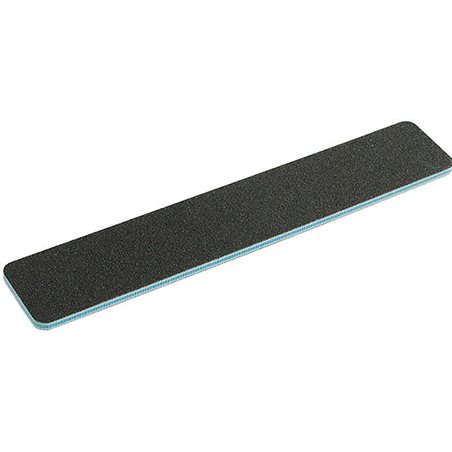
Straight narrow.
Another classic shape, used for the same purposes as the wide one. Narrow files are often chosen for natural nails, while wide ones are used for extensions.

Rhombus.
A file with a stiffer center is convenient for cutting shapes, including squares on long nails, and working near the cuticle.
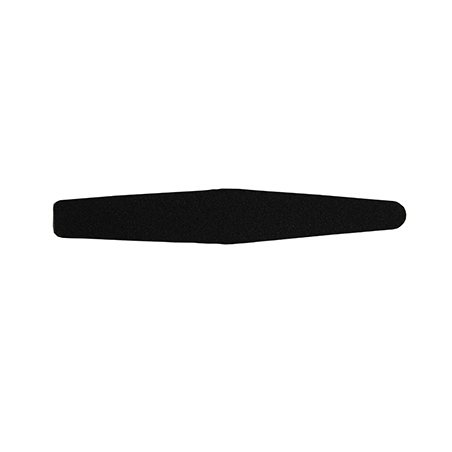
Grater.
A special form of pedicure files designed for treating the skin of the feet.
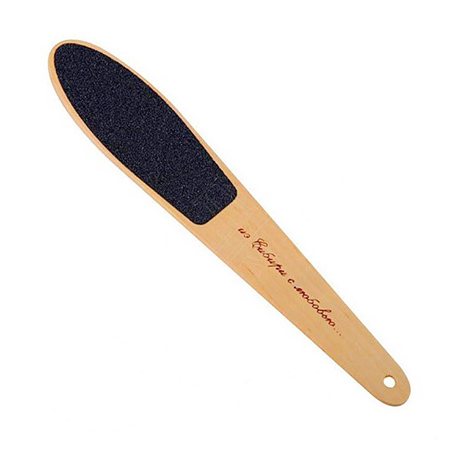
Choosing a manicure file according to its shape is also a matter of comfort. The master himself determines which tool is more convenient for him to work with, and can deviate from the recommendations.
Nail files with replaceable files
They are a set of a reusable base and a set of disposable self-adhesive files with abrasive. The base can be made of acrylic or stainless steel. Files can be thin or with a silicone backing for greater comfort when filing. They also produce small bases and soft buff files.
Steel bases are preferable, since they are subject not only to disinfection, but also to sterilization (read the article about all stages of instrument processing). After working with the client, the replacement file is peeled off from the base and disposed of.
Each manufacturer has its own line of shapes and sizes of both bases and files. The most common ones are long or short oval, rectangular and crescent-shaped (boat). Replaceable files, of course, have different abrasiveness to choose from. To avoid problems with the compatibility of the base and file, it is advisable to purchase both bases and files from the same manufacturer.
The high quality of silicon carbide abrasive, which does not have time to wear out during work with one client, allows the master to work quickly and easily. Silicon carbide does not delaminate the end of the nail and does not leave protruding patches behind. No less important is the safety for the master and the client, which is ensured by sterilization of the base.
It's no surprise that they have gained immense popularity over the past two years. Masters note that after using such files, you don’t want to go back to disposable, cheap, cardboard-based files.
Wave file Butterfly
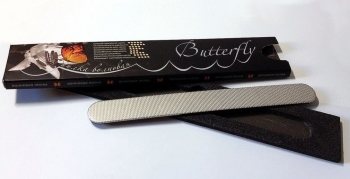
Wave file Butterfly
The wave file has a unique wave surface , which provides four functions: cutting, filing, as well as leveling and polishing.
A wave file can easily replace scissors and nippers. With gentle pressure, the nail hits the wave-blade and is cut off. The file leaves behind a cut that does not require additional soldering.
When filing, Butterfly is used in the same way as a regular file, only it takes less time to manicure.
Types of nail files for home use
At home, you can also use reusable professional files of any shape presented in the article. This is due to the fact that there is no need to sterilize them or throw them away after each use. Simply wash under running water with a soft brush and soap, and then dry. You can use them until the abrasive wears off, and this will happen quite quickly. Below we will look at more reliable options for nail files that do not have to be changed every week.
Metal

They are the most popular in everyday life; they are often included in sets of tools for manicure at home. Their abrasive is durable, so they have not gone out of use for several decades. But, unfortunately, they provoke delamination of the nail plate, which is why thin nails become even thinner and brittle.
In professional practice, such files are used in pedicure. They are flat and allow you to file the corners of your toenails neatly and safely.
Glass

They are quite fragile, so they should not be dropped and should not be carried with you in your bag all the time. Original glass files, when filing, seem to seal the free edge, preventing delamination. So those with soft and thin nails can choose them for home care. They are not suitable for cutting artificial materials.
Ceramic

Similar to glass ones, they very carefully file down the free edge. They can also be used to clean off pterygium on the nail plate if the need arises for a European manicure.
Laser

They appeared on the Russian market about ten years ago and continue to gain popularity. They are made of metal or plastic coated with diamond. A pattern resembling perforation is visible on the surface of the files. This pattern is applied with a laser, which is why the files got their name. They file quite carefully, so they are suitable for thin natural nails. These files can also be used to treat leather.
As a rule, all these types of files do not indicate abrasiveness. Therefore, when purchasing, ask the seller for medium or fine abrasive, or carefully read the description on the label.
Rules for work
There are several rules, following which, you can get a chic manicure at home without harming your nails and the skin around them.
- Before starting work, make sure that the nail plates are dry. After steaming or applying nutrients, wipe dry and degrease the surface of the nails and the skin around them.
- The movement of the file is always directed from the edge of the nail to its center. This allows you to minimize the possibility of damage and achieve maximum effect.
- Sanding is done with special buff files. You should not polish the nail plate with any available nail file.
- Files for the care of artificial and natural nails differ in the degree of abrasiveness. Use files with suitable abrasiveness to avoid damaging your nails, skin and file. This is possible if a file suitable for working with natural nails was chosen for artificial nails.
- It is best to do the nail polishing procedure no more than once a week.
- After treating the skin and nails, it is necessary to use moisturizing or nourishing cosmetics.
When choosing this important tool for caring for fingernails and toenails, be guided by your preferences, tasks and functions that the file will need to cope with.
Comment
Video: tips for choosing a nail file.
At the end of the article I would like to share a useful video with blog readers. In it, the manicurist briefly gives very useful practical advice on choosing this manicure tool (however, you can see everything that was written above in the video
